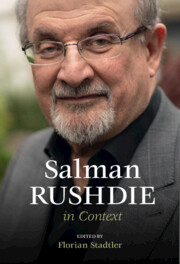Book contents
- Salman Rushdie in Context
- Salman Rushdie in Context
- Copyright page
- Dedication
- Contents
- Contributors
- Acknowledgements
- Introduction
- Part I Life
- Part II Literary and Creative Contexts
- Part III Historical and Cultural Contexts
- Chapter 10 Salman Rushdie and History
- Chapter 11 Religious and Ideological Mythologies in Salman Rushdie’s Novels
- Chapter 12 Revisiting the City in Rushdie’s Fiction
- Chapter 13 Nationalism and Transnationalism in Salman Rushdie’s Novels
- Chapter 14 Rushdie and Globalization
- Chapter 15 Salman Rushdie and Diasporic Identities
- Chapter 16 Rushdie and Secularism
- Chapter 17 Orientalism, Terrorism, and Counterinsurgency in Salman Rushdie’s Novels
- Chapter 18 Salman Rushdie’s Upwardly Mobile, Globally Migrating Middle Classes
- Chapter 19 Scheherazade and Her Cousins
- Chapter 20 Filmi Contexts
- Chapter 21 Salman Rushdie and World-Historical Capitalism
- Chapter 22 The Anthropocene and Ecological Limits in the Works of Salman Rushdie
- Part IV Critical Theoretical Contexts
- Part V Reception, Criticism, and Adaptation
- Works by Salman Rushdie
- Select Bibliography
- Index
Chapter 22 - The Anthropocene and Ecological Limits in the Works of Salman Rushdie
from Part III - Historical and Cultural Contexts
Published online by Cambridge University Press: 23 March 2023
- Salman Rushdie in Context
- Salman Rushdie in Context
- Copyright page
- Dedication
- Contents
- Contributors
- Acknowledgements
- Introduction
- Part I Life
- Part II Literary and Creative Contexts
- Part III Historical and Cultural Contexts
- Chapter 10 Salman Rushdie and History
- Chapter 11 Religious and Ideological Mythologies in Salman Rushdie’s Novels
- Chapter 12 Revisiting the City in Rushdie’s Fiction
- Chapter 13 Nationalism and Transnationalism in Salman Rushdie’s Novels
- Chapter 14 Rushdie and Globalization
- Chapter 15 Salman Rushdie and Diasporic Identities
- Chapter 16 Rushdie and Secularism
- Chapter 17 Orientalism, Terrorism, and Counterinsurgency in Salman Rushdie’s Novels
- Chapter 18 Salman Rushdie’s Upwardly Mobile, Globally Migrating Middle Classes
- Chapter 19 Scheherazade and Her Cousins
- Chapter 20 Filmi Contexts
- Chapter 21 Salman Rushdie and World-Historical Capitalism
- Chapter 22 The Anthropocene and Ecological Limits in the Works of Salman Rushdie
- Part IV Critical Theoretical Contexts
- Part V Reception, Criticism, and Adaptation
- Works by Salman Rushdie
- Select Bibliography
- Index
Summary
This chapter discusses Rushdie’s work in the context of ecocritical considerations, which have increasingly preoccupied critics in the age of the Anthropocene. The representations of Rushdie’s urban and rural environments directly intersect with issues around environmental toxification, droughts, and famines. This is explored through urban planning and the spectre of postcolonial developmental policies, through, for example, the building of hydroelectric dams. Yet Rushdie brings to these considerations a further dimension in his novel The Ground Beneath Her Feet, where these issues take most prominence. The metaphors of ground splitting, earthquakes, and environmental disaster are here closely intertwined. Shalimar the Clown engages with the toxification of the Kashmir valley through military hardware, and Two Years Eight Months and Twenty-Eight Nights, featuring a gardener as its central character, also considers the post-apocalyptic world of New York, when the known world is altered after New York is hit by a storm. This little explored aspect of Rushdie’s work opens up a new critical conceptual dimension and illuminates important environmental concerns of his later novels.
- Type
- Chapter
- Information
- Salman Rushdie in Context , pp. 278 - 290Publisher: Cambridge University PressPrint publication year: 2023

